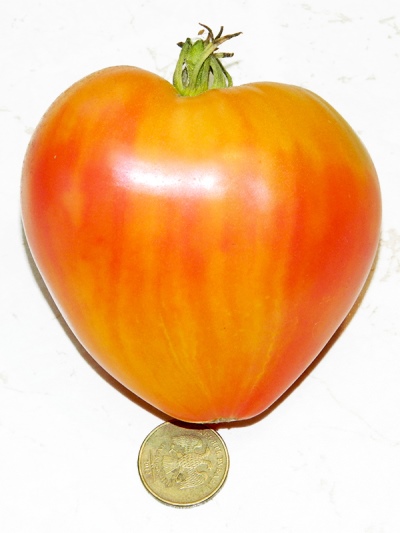
- Authors: Jean-Claude Bosher, France
- Appeared when crossing: Red Zebra x Italian Oxheart (Coeur de bueuf)
- Name synonyms: Heart of Zebre Apricot, Zebra Heart Apricot, Coeur De Zebre Apricot, Zebra Heart Apricot
- Category: grade
- Growth type: indeterminate
- Appointment: fresh consumption
- Ripening period: mid-season
- Ripening time, days: 110-120
- Growing conditions: for open ground, for greenhouses
- Bush size: tall
The heart of an apricot zebra - a tomato with such an original name also has an unusual look. Instead of the usual round tomatoes, we see graceful, pronounced heart shapes, slightly elongated. The color is also unusual for the nightshade culture - bicolor: the main color is apricot yellow, and there are red stripes along it. And the excellent taste with the most delicate pulp generally resembles some kind of exotic fruit, referring this vegetable to delicacies.
Breeding history
This very beautiful French variety, created by breeder Jean-Claude Bosher, turned out to be quite fruitful. As parent varieties, the specialist used Red Zebra and Italian Bovine Heart (Coeur de bueuf).
In America, the culture is better known as the Heart of Zebre Apricot. There are also other names: Coeur De Zebre Apricot, Zebra Apricot Heart.
Description of the variety
The indeterminate type of development makes the plant rather tall. So, in the greenhouse, the bush grows up to 1.7-1.8 meters. At the same time, it has a thin barrel. Can also be grown outdoors. The foliage is of a common, simple type, each brush forming 3 to 6 ovaries.
The main qualities of the fruit
Of course, the main feature of a variety like Apricot Zebra Heart will be the shape and color of its fruits. First of all, they are very beautiful - the refined shape of the hearts has pronounced lush shoulders. When ripe, their color is bright orange, with characteristic red stripes and stains. At the same time, the pulp of tomatoes is orange, with the inclusion of bright raspberry strokes, has a rich aroma. In section it looks very impressive, therefore it is often used in slicing.
In weight, the fruits usually gain from 120 to 250 grams, but there are also larger specimens, up to half a kilogram - this is mainly the result of the efforts of gardeners.
Taste characteristics
French tomatoes are not only beautiful but also delicious. They have a sweet fruity aftertaste with few seeds. Due to the multi-colored, almost marble, fleshy and oily pulp, tomatoes are most often used for fresh consumption. They can decorate any feast.
Ripening and fruiting
The described tomato belongs to the mid-season group of plants. Ripening will occur 110-120 days after seed germination.
Yield
Tomato from France also has good yields, which, among other things, are quite stable. One bush regularly produces 4 to 5 kilograms of wonderful vegetables.
The timing of planting seedlings and planting in the ground
As for planting seeds for seedlings, one should be guided by certain conditions of a particular region, as well as weather disasters. The main rule that should be observed is that at the time of transplanting the grown seedlings to an open bed or to a greenhouse, the age of the seedlings should be within 60-65 days.

Growing tomato seedlings is an extremely important process, because it largely depends on whether the gardener will be able to harvest at all.All aspects must be taken into account, from seedbed preparation to planting in the ground.
Landing scheme
In order for varietal plants to have enough nutrition and sunlight, you should not plant more than three bushes of French seedlings per square meter.

Growing and care
Leaving after planting plants in the ground (open or under a roof) does not differ much from the standard agricultural technique when growing this nightshade crop.
Grasshopping, garter to a support are important elements of cultivating a French-bred tomato. The formation of bushes in 1-2 stems is recommended, with preference given to two trunks.
Watering is traditionally done in moderation, followed by loosening and mulching the soil. Do not forget about the prevention of fungal diseases, as well as pest attacks.
If cultivation takes place in a greenhouse, it must be regularly ventilated.




A plant needs different micronutrients at each stage of growth. All fertilizers can be divided into two groups: mineral and organic. Folk remedies are often used: iodine, yeast, bird droppings, eggshells.
It is important to observe the rate and period of feeding. This also applies to folk remedies and organic fertilizers.



























































































